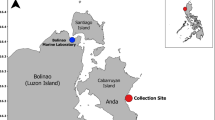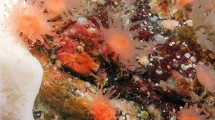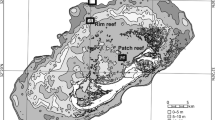Abstract
The present study examines (1) the cost of reproduction on colony growth, and (2) relationships among sexual maturity, whole-colony mortality rate and colony growth rate inGoniastrea aspera free from external influences by macrobenthos. Survival of colonies in permanent plots was followed for two years. Egg production by polyps in colonies collected just before the first spawning of a year was estimated by dissecting the polyps. Growth of the colonies (increase in number of polyps) was followed over one annual reproductive cycle. The cost of egg production on colony growth was apparent through colony ontogeny: (1) immature colonies had a greater annual growth rate than mature colonies, but produced almost no eggs; (2) in mature colonies, growth rate was negatively correlated with NE/PV (number of eggs per polyp volume mm-3). Annual whole-colony mortality was high in colonies with fewer than11 polyps in initial colony size, while mortality was extremely low once a colony grew beyond this size. This critical size for low whole-colony mortality was much smaller than the colony size (40 polyps) which would attain maturity one year later. Age at maturity was estimated as six years. While survival to maturity may be a selective force for the evolution of delayed maturation, the present data suggest that high colony fecundity, achieved after a long growth period as an immature colony, and an abrupt decrease of colony growth rate after maturation are the crucial forces.
Similar content being viewed by others
References
Babcock, R. C. (1991) Comparative demography of three species of scleractinian corals using age- and size-dependent classifications.Ecological Monographs 61: 225–244.
Chornesky, E. A. and E. C. Peters (1987) Sexual reproduction and colony growth in the scleractinian coralPorites astreoides.Biological Bulletin 172: 161–177.
Hayashibara, T., K. Shimoike, T. Kimura, S. Hosaka, A. Heyward, P. Harrison, K. Kudo and M. Omori (1993) Patterns of coral spawning at Akajima Island, Okinawa Japan.Marine Ecology Progress Series 101: 253–262.
Heyward, A., K. Yamazato, T. Yeemin and M. Minei (1987) Sexual reproduction of corals in Okinawa.Galaxea 6: 331–343.
Hughes, T. P. and J. H. Connell (1987) Population dynamics based on size or age? a reef-coral analysis.American Naturalist 129: 818–829.
Hughes, T. P. and J. B. C. Jackson (1985) Population dynamics and life histories of foliaceous corals.Ecological Monographs 55: 141–166.
Hughes, T. P., D. Ayre and J. H. Connell (1992) The evolutionary ecology of corals.Trends in Ecology and Evolution 7: 292–295.
Jackson, J. B. C. (1985) Distribution and ecology of clonal and aclonal benthic invertebrates, pp. 297–356In J. B. C. Jackson, L. W. Buss and R. E. Cook (eds.)Population biology and evolution of clonal organisms. Yale University Press, New Haven.
Jackson, J. B. C. and T. P. Hughes (1985) Adaptive strategies of coral-reef invertebrates.American Scientist 73: 265–274.
Johnson, K. G. (1992) Population dynamics of a free-living corals: recruitment, growth and survivorship ofManicina areolata (Linnaeus) on the Caribbean coast of Panama.Journal of Experimental Marine Biology and Ecology 164: 171–191.
Kojis, B. L. and N. J. Quinn (1981) Aspects of sexual reproduction and larval development in the shallow water hermatypic coral,Goniastrea australiensis (Edwards and Haime, 1857).Bulletin of Marine Science 31: 558–573.
Kojis, B. L. and N. J. Quinn (1984) Seasonal and depth variation in fecundity ofAcropora palifera at two reefs in Papua New Guinea.Coral Reefs 3: 165–172.
Loya, Y. (1976) The Red Sea coralStylophora pistillata is anr strategist.Nature 259: 478–480.
Partridge, L. and P. H. Harvey (1985) The costs of reproduction.Nature 316: 20–21.
Partridge, L. and R. Sibly (1991) Constraints in the evolution of life histories.Philosophical Transactions of the Royal Society of London B 332: 3–13.
Reznick, D. (1985) Costs of reproduction: an evaluation of the empirical evidence.Oikos 44: 257–267.
Rinkevich, B. and Y. Loya (1979) The reproduction of the Red Sea CoralStylophora pistillata, II. Synchronization in breeding and seasonality of planulae shedding.Marine Ecology Progress Series 1: 145–152.
Rinkevich, B. and Y. Loya (1985) Intraspecific competition in a reef coral: effect on growth and reproduction.Oecologia 66: 100–105.
Roff, D. A. (1992)The evolution of life histories. Chapman & Hall, London.
Sakai, K. (1997) Gametogenesis, spawning, and planula brooding by the reef coralGoniastrea aspera (Scleractinia) in Okinawa, Japan.Marine Ecology Progress Series 151: 67–72.
Soong, K. (1993) Colony size as species character in massive reef corals.Coral Reefs 12: 77–83.
Stearns, S. C. (1992)The evolution of life histories. Oxford University Press, New York.
Szmant, A. M. (1986) Reproductive ecology of Caribbean reef corals.Coral Reefs 4: 43–54.
Takada, T. and H. Caswell (1997) Optimal size at maturity in sizestructured populations.Journal of Theoretical Biology 187: 81–93.
Tanner, J. E. (1997) Interspecific competition reduces fitness in scleractinian corals.Journal of Experimental Marine Biology and Ecology 214: 19–34.
Tomascik, T. and F. Sander (1985) Effects of eutrophication on reef-building corals. I. Growth rate of the reef-building coralMontastrea annularis.Marine Biology 87: 143–155.
Tunnicliffe, V. (1981) Breakage and propagation of the stony coralAcropora cervicornis.Proceeding of the National Academy of Science of the USA 78: 2427–2431.
Author information
Authors and Affiliations
Corresponding author
Rights and permissions
About this article
Cite this article
Sakai, K. Delayed maturation in the colonial coralGoniastrea aspera (Scleractinia): whole-colony mortality, colony growth and polyp egg production. Res Popul Ecol 40, 287–292 (1998). https://doi.org/10.1007/BF02763460
Received:
Accepted:
Issue Date:
DOI: https://doi.org/10.1007/BF02763460




